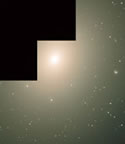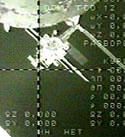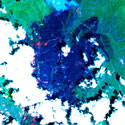
Image credit: Hubble
Astronomers have spotted a number of young stellar clusters dotted around a very old elliptical galaxy – this disputes the established theory that old galaxies contain only older stars. The team used the Hubble Space Telescope and the ESO Very Large Telescope to take a series of images of galaxy NGC 4365, and they were able to identify star clusters that were only a few billion years old, while the majority were over 12 billion years old. Why the galaxy contains such a combination of young and old stars is still a mystery.
Combining data from the NASA/ESA Hubble Space Telescope and the ESO Very Large Telescope (VLT), a group of European and American astronomers have made a major discovery. They have identified a huge number of ‘young’ stellar clusters, in an old elliptical galaxy.
For the first time, it has been possible to identify several distinct periods of star formation in a galaxy as old as this one. Elliptical galaxies have always been considered to have undergone one early star-forming period and thereafter to be devoid of star formation. However, the combination of the best and largest telescopes in space and on the ground has now clearly shown that there is more than meets the eye.
Do elliptical galaxies only contain old stars?
One of the challenges of modern astronomy is to understand how galaxies – large systems of stars, gas and dust – form and evolve. When did most of the stars in the Universe form? Did this happen at a very early stage, within a few billion years of the Big Bang? Have a significant number of the stars we now observe formed much more recently?
Spectacular collisions between galaxies take place all the time, triggering the formation of thousands or even millions of stars. However, when looking at the Universe as a whole, most of its stars are found in elliptical galaxies whose overall appearance has so far led us to believe that they, and their stars and as well, are old.
These elliptical galaxies do shine with the diffuse, reddish glow normally associated with stars that are many thousand million years old. However, what is the underlying mix of stars that produces this elderly appearance? Could a significant number of much younger stars be ‘hiding’ among the older ones?
Detailed observations with the world’s premier telescopes have now cast new light on this central question about the behaviour of some of the major building blocks of the Universe.
Cosmic paleonthology
To break the stellar ‘cocktail’ in elliptical galaxies down into its different constituents, a team of European and American astronomers observed massive stellar clusters in and around nearby galaxies. These “globular” clusters, so called because of their shape, exist in large numbers around all observed galaxies and form a kind of ‘skeleton’ within their host galaxies. These ‘bones’ receive an imprint for every episode of star formation they undergo. By reading the ages of the globular clusters in a galaxy, it is possible to identify the past epoch(s) of active star formation in a galaxy.
Reading the imprints and deducing the distribution of ages of the globular clusters, astronomers can reveal when many of the stars in elliptical galaxies formed. This is similar to the way a palaeontologist uses the skeletons of dinosaurs to deduce information about the era in which they lived.
A surprising discovery
The team combined images of a number of galaxies from Hubble’s Wide Field and Planetary Camera 2 with infrared images obtained from the multi-mode ISAAC instrument on the 8.2m VLT Antu telescope at the ESO Paranal Observatory (Chile). To their great surprise, they discovered that many of the globular clusters in one of these galaxies, NGC 4365, a member of the large Virgo cluster of galaxies, were only a few thousand million years old, much younger than most of the other stars in this galaxy (roughly 12 thousand million years old).
The astronomers were able to identify three major groups of stellar clusters. There is an old population of clusters of metal-poor stars, some clusters of old but metal-rich stars and now, seen for the first time, a population of clusters with young and metal-rich stars.
These results have been fully confirmed by spectroscopic observations made with another of the world’s giant telescopes, the 10-metre Keck on Hawaii.
“It is a great pleasure to see two projects wholly or partly funded by Europe – VLT and Hubble – work in concert to produce such an important scientific result”, says Piero Benvenuti, ESA Hubble Project Scientist. “The synergy between the most advanced ground and space telescopes continues to prove its effectiveness, paving the way to impressive new discoveries that would not otherwise be possible.”
The discovery of young globular clusters within old galaxies is surprising since the stars in the giant elliptical galaxies were until now believed to have formed during a single period early in the history of the Universe. It is now clear that some of the galaxies may be hiding their true nature and have indeed experienced much more recent periods of major star formation.
Original Source: ESA News Release



